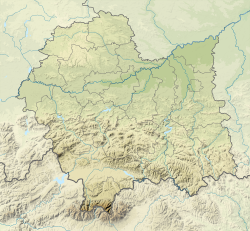
Back منجم فياليتشكا الملحي Arabic Тоҙ шахтаһы (Величка) Bashkir Саляная шахта ў Вялічцы Byelorussian Саляная шахта Вялічка BE-X-OLD Солна мина „Величка” Bulgarian Mines de sal de Wieliczka Catalan Solný důl Wieliczka Czech Wieliczka saltmine Danish Salzbergwerk Wieliczka German Αλατωρυχείο Βιελίτσκα Greek
| UNESCO World Heritage Site | |
|---|---|
 St. Kinga's Chapel, deep in the Wieliczka salt mine | |
| Location | Wieliczka, Kraków County, Lesser Poland Province, Poland |
| Part of | Wieliczka and Bochnia Royal Salt Mines |
| Includes |
|
| Criteria | Cultural: (iv) |
| Reference | 32ter |
| Inscription | 1978 (2nd Session) |
| Extensions | 2008, 2013 |
| Endangered | 1989–1998[1] |
| Area | 970 ha (2,400 acres) |
| Buffer zone | 250 ha (620 acres) |
| Website | www |
| Coordinates | 49°58′45″N 20°3′50″E / 49.97917°N 20.06389°E |
The Wieliczka Salt Mine (Polish: Kopalnia soli Wieliczka) is a salt mine in the town of Wieliczka, near Kraków in southern Poland.
From Neolithic times, sodium chloride (table salt) was produced there from the upwelling brine. The Wieliczka salt mine, excavated from the 13th century, produced table salt continuously until 1996,[2] as one of the world's oldest operating salt mines. Throughout its history, the royal salt mine was operated by the Żupy Krakowskie (Kraków Salt Mines) company.[3][4]
Due to falling salt prices and mine flooding, commercial salt mining was discontinued in 1996.[3][4]
The Wieliczka Salt Mine is now an official Polish Historic Monument (Pomnik Historii) and a UNESCO World Heritage Site. Its attractions include the shafts and labyrinthine passageways, displays of historic salt-mining technology, an underground lake, four chapels and numerous statues carved by miners out of the rock salt, and more recent sculptures by contemporary artists.
- ^ Cite error: The named reference
UNESCO-1998was invoked but never defined (see the help page). - ^ "History of the Mine". www.wieliczka-saltmine.com. Retrieved 3 December 2023.
- ^ a b "Wieliczka – The Salt of the Earth"
- ^ a b Ancient salt-works. Wieliczka see: carving by Jozef Markowski, late 19th century. (Internet Archive). Retrieved 31 July 2013.

